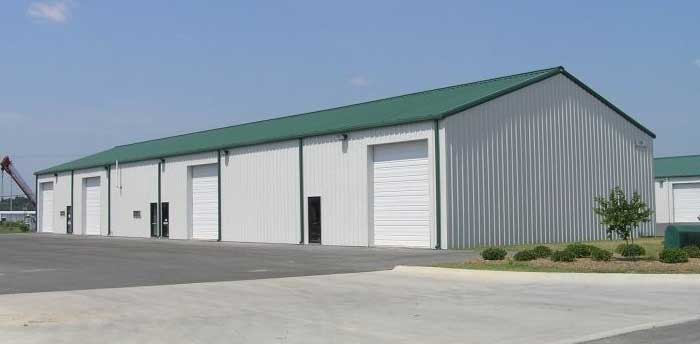Industrial sheds are an essential part of modern infrastructure, providing versatile, cost-effective, and durable solutions for businesses of all sizes. Whether you’re looking for a storage solution, a manufacturing facility, or a space for warehousing, an industrial shed can meet your needs efficiently. In this article, we will explore the various types of industrial sheds, the benefits they offer, and key considerations to keep in mind when building or renting one for your business.
What Are Industrial Sheds?
Industrial sheds are large, open spaces used primarily for industrial, commercial, or storage purposes. They are typically made from steel or metal frames, with a large roof span and open internal space that allows businesses to carry out various operations such as manufacturing, assembly, storage, and warehousing. The design of industrial sheds can vary greatly depending on the intended use, from simple structures for storage to complex buildings that house factories and machinery.
These structures are known for their flexibility, durability, and cost-effectiveness, making them an ideal choice for companies looking for practical space solutions. They can be custom-built to meet specific business needs, providing a variety of configurations such as single-story sheds, multi-story units, or even modular sheds.
Types of Industrial Sheds
- Storage Sheds: Storage sheds are primarily used to store goods, equipment, or materials. They are typically large and have minimal internal fittings, offering open space to house everything from raw materials to finished products. They often feature large roller doors for easy access and can be equipped with racking systems for organized storage.
- Warehouse Sheds: Warehouse sheds are designed for businesses that require large-scale storage and distribution capabilities. These sheds often come with enhanced features such as higher roofs, strong flooring, and ventilation systems to maintain air quality and temperature control. Businesses involved in logistics, distribution, or retail often choose warehouse sheds for their scalable design.
- Manufacturing Sheds: Manufacturing sheds are designed to accommodate heavy machinery, assembly lines, and operational equipment. These sheds are typically reinforced to handle the weight of industrial machinery and have large open spaces to allow for smooth workflow and easy mobility. Depending on the nature of the manufacturing process, manufacturing sheds may include office space, utility areas, and special safety features.
- Custom-Built Sheds: Some businesses require specialized sheds to meet unique operational needs. Custom-built industrial sheds can be designed to accommodate specific requirements such as specialized cooling, ventilation, or electrical systems. These sheds can also be designed to integrate into existing facilities or expand upon them.
- Modular Sheds: Modular industrial sheds are prefabricated structures that can be quickly assembled on-site. They are ideal for businesses looking for temporary or expandable spaces. Modular sheds are versatile, cost-effective, and can be moved or adapted as business needs change.
Benefits of Industrial Sheds
- Cost-Effectiveness: One of the main advantages of industrial sheds is their affordability compared to traditional brick-and-mortar buildings. Industrial sheds are made with durable, lightweight materials like steel, which are relatively inexpensive. Furthermore, the construction process is faster and more straightforward, reducing labor and material costs.
- Durability: Industrial sheds are designed to withstand harsh weather conditions, heavy loads, and long-term use. They are built to last, with materials like galvanized steel providing resistance against corrosion, rust, and wear. As a result, businesses can enjoy long-term value without frequent maintenance costs.
- Flexibility and Scalability: Industrial sheds can be easily expanded or modified to meet the growing needs of a business. For example, if a business outgrows its current space, additional modules or extensions can be added to the existing shed. This flexibility allows businesses to adapt their facilities as their operations change over time.
- Speed of Construction: Compared to traditional buildings, industrial sheds can be constructed relatively quickly. Pre-engineered steel structures and modular components can be assembled in a matter of weeks, meaning businesses can move into their new space sooner. This speed of construction is particularly useful for businesses that need to set up operations quickly.
- Low Maintenance: The materials used in industrial sheds, such as steel, require minimal maintenance. Unlike wooden structures, which may be susceptible to pests, rot, and weathering, steel structures are durable and can withstand the test of time with very little upkeep.
- Energy Efficiency: Many modern industrial sheds are designed with energy efficiency in mind. With features like insulated roofing, proper ventilation, and energy-efficient lighting, businesses can reduce operational costs and minimize their environmental impact. This is particularly important for businesses looking to improve sustainability and reduce energy bills.
Key Considerations for Building or Renting an Industrial Shed
When choosing an industrial shed, there are several factors to consider to ensure that you select the right space for your business.
- Location: The location of your industrial shed plays a crucial role in the success of your business. Consider factors such as proximity to suppliers, customers, transport routes, and workforce availability. A well-located shed can reduce logistics costs and improve overall efficiency.
- Zoning and Permits: Before constructing or renting an industrial shed, it’s important to check local zoning regulations to ensure that your intended use complies with the area’s rules. You may need to apply for permits, especially if you plan to use the shed for manufacturing or heavy machinery operations.
- Design and Layout: The design and layout of the industrial shed should reflect your operational needs. For instance, if you need a shed for warehousing, you’ll want to consider high ceilings, large doors, and good lighting. If you plan to set up an assembly line or factory floor, you’ll need to ensure that the layout allows for the efficient flow of materials and workers.
- Safety Standards: Depending on the type of work conducted in the industrial shed, safety standards are critical. Ensure that your shed complies with local building codes and safety regulations. This may include fire safety measures, emergency exits, ventilation systems, and electrical wiring safety.
- Budget: While industrial sheds are generally more cost-effective than traditional buildings, the overall cost can vary based on size, design, and features. Set a budget before starting the project to ensure that you don’t overspend. It’s also important to consider ongoing costs such as utilities, insurance, and maintenance.
- Sustainability: Many businesses today are focusing on sustainability, and this extends to the construction and operation of industrial sheds. Consider incorporating energy-efficient materials, renewable energy sources (such as solar panels), and waste management systems to make your shed more eco-friendly.
Conclusion
Industrial sheds are versatile, cost-effective solutions that can support a wide range of business needs, from storage and warehousing to manufacturing and distribution. With their durability, flexibility, and quick construction times, they offer businesses an ideal way to expand operations, streamline logistics, and optimize workflow. By considering key factors such as location, design, safety, and sustainability, you can ensure that your industrial shed provides long-term value and supports the growth of your business. Whether you’re constructing a new facility or renting an existing one, industrial sheds can help you build the foundation for your success.


